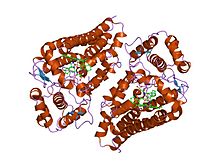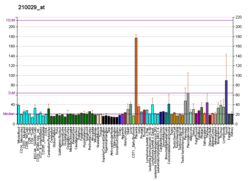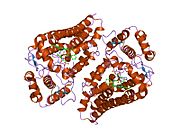인돌아민 2,3-이산소화효소
| 인돌아민 2,3-이산소화효소 | |||||||||
|---|---|---|---|---|---|---|---|---|---|
 4-페닐이미다졸이 결합한 형태의 사람 인돌아민 2,3-이산소화효소 결정 구조 | |||||||||
| 식별자 | |||||||||
| 상징 | IDO | ||||||||
| Pfam | PF01231 | ||||||||
| Pfam clan | CL0380 | ||||||||
| InterPro | IPR000898 | ||||||||
| PROSITE | PDOC00684 | ||||||||
| |||||||||
| 인돌아민 2,3-이산소화효소 | |||||||||
|---|---|---|---|---|---|---|---|---|---|
| 식별자 | |||||||||
| EC 번호 | 1.13.11.52 | ||||||||
| CAS 번호 | 9014-51-1 | ||||||||
| 데이터베이스 | |||||||||
| IntEnz | IntEnz view | ||||||||
| BRENDA | BRENDA entry | ||||||||
| ExPASy | NiceZyme view | ||||||||
| KEGG | KEGG entry | ||||||||
| MetaCyc | metabolic pathway | ||||||||
| PRIAM | profile | ||||||||
| PDB 구조 | RCSB PDB PDBj PDBe PDBsum | ||||||||
| 유전자 온톨로지 | AmiGO / QuickGO | ||||||||
| |||||||||
인돌아민(-피롤) 2,3-이산소화효소(indoleamine-pyrrole 2,3-dioxygenase, IDO 또는 INDO, EC 1.13.11.52)는 작은창자, 폐, 여성 생식기나 태반과 같은 여러 조직과 세포에서 생리적으로 발현되는 헴을 함유한 효소이다.[5] 인간의 경우 IDO1 유전자에 의해 암호화된다.[6] IDO는 트립토판의 대사에 관여하는데, 구체적으로는 키뉴레닌 경로의 첫 번째이자 속도 제한 단계인 L-트립토판이 N-폼일키뉴레닌으로 O2 의존적으로 산화되는 것을 촉매하는 세 가지 효소 중 하나이다. 이 과정을 촉매하는 나머지 두 효소는 인돌아민 2,3-이산소화효소 2(IDO2)[7]와 트립토판 2,3-이산소화효소(TDO)가 있다.[8] IDO는 면역계의 중요한 효소이며 다양한 병원체에 대한 자연적인 방어선 역할을 한다.[9][10] 염증에 대한 반응으로 세포에 의해 생산되어 T세포 기능을 제한하고 면역관용 기전에 관여하는 능력 때문에 면역억제 기능을 가지고 있다.[11] 새로운 근거에 따르면 IDO는 종양 발달 중에 활성화되어 악성 세포가 면역계에 의해 박멸되는 것을 회피할 수 있도록 도와준다. IDO의 발현은 급성 골수성 백혈병, 난소암, 대장암과 같은 여러 유형의 암에서 나타났다. IDO는 악성 형질전환 과정의 일부이며 신체의 항종양 면역 반응을 억제하는 데 핵심적인 역할을 하므로 이 효소를 억제하면 화학요법이나 기타 면역치료 프로토콜의 효과가 증가할 수 있다.[12][13][14]
생리적 기능
[편집]인돌아민 2,3-이산소화효소는 키뉴레닌 경로를 통한 트립토판 이화작용의 첫 단계이자 속도 제한 단계를 촉매하는 효소이다.
IDO는 면역관용 기전에서 중요한 분자이며 생리학적 기능에는 신체에서 잠재적으로 위험한 염증 과정의 억제가 있다.[15] 또한 IDO는 미생물에 대한 자연 방어 역할을 한다. IDO의 발현은 인터페론 감마에 의해 유도되는데, 이는 염증성 질환이나 종양 형성 중에도 IDO 발현이 증가하는 이유이다.[16] 트립토판은 병원체의 생존에 필수적이기 때문에 효소 IDO의 활성은 병원체를 파괴한다. 트립토판 결핍에 민감한 미생물에는 연쇄상구균[17]에 속하는 세균이나 헤르페스 심플렉스 바이러스,[18] 홍역모빌리바이러스와 같은 바이러스가 있다.[19]
IDO 발현이 높은 기관 중 하나는 태반이다. 1990년대에 있었던 태반에서 일어나는 트립토판 대사에 대한 연구로 인해 생쥐에서 처음 이 효소의 면역억제 기능이 기술되었다. 포유류의 태반에서는 집중적인 트립토판 이화작용이 일어나 T세포 활동이 억제된다. 이 기전은 태반이 면역특혜 조직이 되는 데에 기여한다.[20]
임상적 중요성
[편집]IDO는 M2 대식세포와 기타 면역조절 세포에 의해 생성되는 면역조절 효소로서 면역관문 분자의 역할을 한다.[21] IDO는 T세포와 NK 세포를 억제하고, 조절 T세포와 골수 유래 면역억제세포를 생성하고 혈관신생을 돕는 것으로 알려져 있다.[12]
이러한 기전은 발암 과정에서 중요하다. IDO는 종양 세포가 두 가지 주요 기전을 통해 면역계 작용을 벗어날 수 있도록 한다. 첫 번째 기전은 종양 미세환경에서 트립토판을 고갈시키는 것을 기반으로 한다.[22] 두 번째 기전은 T세포와 NK 세포에 대해 세포독성을 나타내는 키뉴레닌이라고 하는 이화작용 산물의 생산에 기반을 두고 있다.[23] 사람 IDO(hIDO)의 과발현은 다양한 인간 종양 세포 계통에서 나타나며 종종 불량한 예후와 관련되어 있다.[24][25] IDO 생산이 증가되는 종양에는 전립샘암, 난소암, 폐암, 췌장암, 급성 골수성 백혈병이 있다.[26][27] IDO의 발현은 Bin1 유전자에 의해 조절되는 생리학적 조건 하에 있으며, 이 생리학적 조건은 종양 변형에 의해 손상될 수 있다.[28]
새로운 임상적 연구에 따르면 IDO 억제제와 기존의 화학요법, 방사선 치료 요법의 조합은 면역 조절을 회복하고 일반적으로 내성이 있는 종양에 대한 치료 반응을 이끌어낼 수 있다. 면역감시를 피하기 위해 종양이 사용하는 효소 IDO는 현재 연구와 신약 개발 노력에서 주목을 받고 있으며[29] IDO를 예후를 예측하기 위한 바이오마커로 이용할 수 있는지 알아내려는 노력도 이루어지고 있다.[30]
억제제
[편집]COX-2 억제제는 IDO를 하향조절하여 키뉴레닌 수치를 감소시키고 염증성 사이토카인 활성을 감소시킨다.
1-메틸트립토판은 인돌아민 이산소화효소를 약하게 억제하지만 매우 느린 기질이기도 한 라세미 혼합물이다. 인독시모드로 알려진 1-메틸 D 트립토판은 다양한 암에 대한 임상 시험이 이루어지는 중이다.
에파카도스탯(INCB24360)과 나복시모드(GDC-0919)는 인돌아민 2,3-이산소화효소의 강력한 억제제이며 다양한 암에 대한 임상 시험 중이다. BMS-986205도 암에 대한 임상시험을 진행 중이다.
각주
[편집]- ↑ 가 나 다 GRCh38: Ensembl release 89: ENSG00000131203 - 앙상블, May 2017
- ↑ 가 나 다 GRCm38: Ensembl release 89: ENSMUSG00000031551 - 앙상블, May 2017
- ↑ “Human PubMed Reference:”. 《National Center for Biotechnology Information, U.S. National Library of Medicine》.
- ↑ “Mouse PubMed Reference:”. 《National Center for Biotechnology Information, U.S. National Library of Medicine》.
- ↑ “Human indolylamine 2,3-dioxygenase. Its tissue distribution, and characterization of the placental enzyme”. 《The Biochemical Journal》 230 (3): 635–8. September 1985. doi:10.1042/bj2300635. PMC 1152665. PMID 3877502.
- ↑ “Entrez Gene: INDO indoleamine-pyrrole 2,3 dioxygenase”.
- ↑ “IDO2 in Immunomodulation and Autoimmune Disease”. 《Frontiers in Immunology》 5: 585. 2014년 11월 20일. doi:10.3389/fimmu.2014.00585. PMC 4238401. PMID 25477879.
- ↑ “Tryptophan Metabolism in Rat Liver After Administration of Tryptophan, Kynurenine Metabolites, and Kynureninase Inhibitors”. 《International Journal of Tryptophan Research》 9: 51–65. January 2016. doi:10.4137/ijtr.s38190. PMC 4982523. PMID 27547037.
- ↑ “Induction of pulmonary indoleamine 2,3-dioxygenase by intraperitoneal injection of bacterial lipopolysaccharide”. 《Proceedings of the National Academy of Sciences of the United States of America》 75 (8): 3998–4000. August 1978. Bibcode:1978PNAS...75.3998Y. doi:10.1073/pnas.75.8.3998. PMC 392917. PMID 279015.
- ↑ “Induction of indoleamine 2,3-dioxygenase in mouse lung during virus infection”. 《Proceedings of the National Academy of Sciences of the United States of America》 76 (8): 4084–6. August 1979. Bibcode:1979PNAS...76.4084Y. doi:10.1073/pnas.76.8.4084. PMC 383982. PMID 291064.
- ↑ “Indoleamine 2,3 dioxygenase and metabolic control of immune responses”. 《Trends in Immunology》 34 (3): 137–43. March 2013. doi:10.1016/j.it.2012.10.001. PMC 3594632. PMID 23103127.
- ↑ 가 나 “Indoleamine 2,3-dioxygenase pathways of pathogenic inflammation and immune escape in cancer”. 《Cancer Immunology, Immunotherapy》 63 (7): 721–35. July 2014. doi:10.1007/s00262-014-1549-4. PMC 4384696. PMID 24711084.
- ↑ “IDO in the Tumor Microenvironment: Inflammation, Counter-Regulation, and Tolerance”. 《Trends in Immunology》 37 (3): 193–207. March 2016. doi:10.1016/j.it.2016.01.002. PMC 4916957. PMID 26839260.
- ↑ “Evidence for a tumoral immune resistance mechanism based on tryptophan degradation by indoleamine 2,3-dioxygenase”. 《Nature Medicine》 9 (10): 1269–74. October 2003. doi:10.1038/nm934. PMID 14502282.
- ↑ “Defective tryptophan catabolism underlies inflammation in mouse chronic granulomatous disease”. 《Nature》 451 (7175): 211–5. January 2008. Bibcode:2008Natur.451..211R. doi:10.1038/nature06471. PMID 18185592.
- ↑ “Indoleamine 2,3-Dioxygenase and Tolerance: Where Are We Now?”. 《Frontiers in Immunology》 8: 1360. 2017년 10월 27일. doi:10.3389/fimmu.2017.01360. PMC 5663846. PMID 29163470.
- ↑ “Interferon-gamma-induced activation of indoleamine 2,3-dioxygenase in cord blood monocyte-derived macrophages inhibits the growth of group B streptococci”. 《The Journal of Infectious Diseases》 178 (3): 875–8. September 1998. doi:10.1086/515347. PMID 9728563.
- ↑ “Role of indoleamine-2,3-dioxygenase in alpha/beta and gamma interferon-mediated antiviral effects against herpes simplex virus infections”. 《Journal of Virology》 78 (5): 2632–6. March 2004. doi:10.1128/jvi.78.5.2632-2636.2004. PMC 369218. PMID 14963171.
- ↑ “Indoleamine 2,3-dioxygenase mediates cell type-specific anti-measles virus activity of gamma interferon”. 《Journal of Virology》 79 (12): 7768–76. June 2005. doi:10.1128/jvi.79.12.7768-7776.2005. PMC 1143631. PMID 15919929.
- ↑ “Prevention of allogeneic fetal rejection by tryptophan catabolism”. 《Science》 281 (5380): 1191–3. August 1998. Bibcode:1998Sci...281.1191M. doi:10.1126/science.281.5380.1191. PMID 9712583.
- ↑ “Targeting the indoleamine 2,3-dioxygenase pathway in cancer”. 《Journal for Immunotherapy of Cancer》 3: 51. 2015. doi:10.1186/s40425-015-0094-9. PMC 4678703. PMID 26674411.
- ↑ Munn, David H.; Shafizadeh, Ebrahim; Attwood, John T.; Bondarev, Igor; Pashine, Achal; Mellor, Andrew L. (1999년 5월 3일). “Inhibition of T Cell Proliferation by Macrophage Tryptophan Catabolism”. 《The Journal of Experimental Medicine》 189 (9): 1363–1372. doi:10.1084/jem.189.9.1363. ISSN 0022-1007. PMC 2193062. PMID 10224276.
- ↑ Frumento, Guido; Rotondo, Rita; Tonetti, Michela; Damonte, Gianluca; Benatti, Umberto; Ferrara, Giovanni Battista (2002년 8월 12일). “Tryptophan-derived Catabolites Are Responsible for Inhibition of T and Natural Killer Cell Proliferation Induced by Indoleamine 2,3-Dioxygenase”. 《The Journal of Experimental Medicine》 196 (4): 459–468. doi:10.1084/jem.20020121. ISSN 1540-9538. PMC 2196046. PMID 12186838.
- ↑ Okamoto, Aikou; Nikaido, Takashi; Ochiai, Kazunori; Takakura, Satoshi; Takao, Miho; Saito, Misato; Aoki, Yuko; Ishii, Nobuya; Yanaihara, Nozomu (November 2007). “Ido serves as a marker of poor prognosis in gene expression profiles of serous ovarian cancer cells”. 《International Congress Series》 1304: 262–273. doi:10.1016/j.ics.2007.07.053. ISSN 0531-5131.
- ↑ Inaba, Tomoko; Ino, Kazuhiko; Kajiyama, Hiroaki; Shibata, Kiyosumi; Yamamoto, Eiko; Kondo, Shinji; Umezu, Tomokazu; Nawa, Akihiro; Takikawa, Osamu (June 2010). “Indoleamine 2,3-dioxygenase expression predicts impaired survival of invasive cervical cancer patients treated with radical hysterectomy”. 《Gynecologic Oncology》 117 (3): 423–428. doi:10.1016/j.ygyno.2010.02.028. ISSN 0090-8258. PMID 20350764.
- ↑ Uyttenhove, Catherine; Pilotte, Luc; Théate, Ivan; Stroobant, Vincent; Colau, Didier; Parmentier, Nicolas; Boon, Thierry; Van den Eynde, Benoît J (2003년 9월 21일). “Evidence for a tumoral immune resistance mechanism based on tryptophan degradation by indoleamine 2,3-dioxygenase”. 《Nature Medicine》 9 (10): 1269–1274. doi:10.1038/nm934. ISSN 1078-8956. PMID 14502282.
- ↑ Jiang, Tianze; Sun, Yingying; Yin, Zhichao; Feng, Sen; Sun, Liping; Li, Zhiyu (February 2015). “Research progress of indoleamine 2,3-dioxygenase inhibitors”. 《Future Medicinal Chemistry》 7 (2): 185–201. doi:10.4155/fmc.14.151. ISSN 1756-8919. PMID 25686005.
- ↑ Muller, Alexander J; DuHadaway, James B; Donover, P Scott; Sutanto-Ward, Erika; Prendergast, George C (2005년 2월 13일). “Inhibition of indoleamine 2,3-dioxygenase, an immunoregulatory target of the cancer suppression gene Bin1, potentiates cancer chemotherapy”. 《Nature Medicine》 11 (3): 312–319. doi:10.1038/nm1196. ISSN 1078-8956. PMID 15711557.
- ↑ “Research progress of indoleamine 2,3-dioxygenase inhibitors”. 《Future Medicinal Chemistry》 7 (2): 185–201. 2015. doi:10.4155/fmc.14.151. PMID 25686005.
- ↑ “The Clinicopathological and Prognostic Significance of IDO1 Expression in Human Solid Tumors: Evidence from a Systematic Review and Meta-Analysis”. 《Cellular Physiology and Biochemistry》 49 (1): 134–143. 2018. doi:10.1159/000492849. PMID 30134237.
외부 링크
[편집]- 의학주제표목 (MeSH)의 Indoleamine-Pyrrole+2,3,-Dioxygenase
- PDBe-KB - 사람의 인돌아민 2,3-이산소화효소에 대한 PDB의 구조 정보







